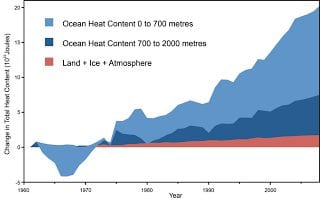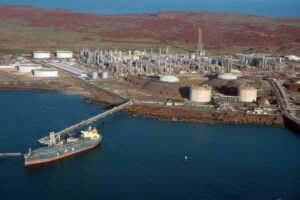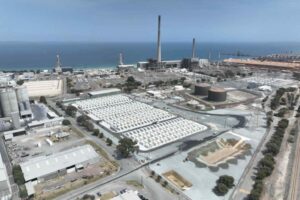In the second of a three part series, David Spratt considers what a victory for Tony Abbott and the Liberal–National Party coalition at Australia’s federal election in September, and conservative domination of Australian parliamentary politics for the remainder of this decade both likely, means for climate policies from the major parties. The first installment can be found here.
 |
| Increasing heat content in the oceans (blue) show the claims that global warmed has “stopped” to be fallacious. Courtesy Skeptical Science. |
LIBERAL–NATIONAL PARTY COALITION (LNP): The federal LNP’s plans are clear: up to $70 billion cuts in government spending, public sectors austerity and up to 35,000 public sector job losses. Think David Cameron in the UK or Campbell Newman in Queensland. Big business will get a free run, the mining profits tax will go, and wealth will be transferred to the top end of town. All in the name of reducing the size of government and reducing regulation to expand the private sector because more, bigger and more profitable markets are our saviour.
Except when it comes the Labor-created market in trading carbon pollution rights, where LNP leader Tony Abbott has promised to axe the market. Surveys find that two-thirds of business leaders think the carbon price will stay, and many hope that Abbott won’t have the Senate numbers. If they do, will Abbott’s delay-and-deny ideology triumph over a basic tenet of neo-liberal capitalism that a free market is a good market, and the more the better?
Investment banker Mark Carnegie says Abbott is “is the person least committed to free market economics of the viable political leaders”. As carbon markets expand internationally, big business – and especially finance capital which thrives by trading and speculating on everything in sight – don’t want to be chopped out of the action. Even ExxonMobil and Shell and BP have called for the carbon tax to stay, which says something both about Abbott’s relationship to business, and how tame is the carbon price.
If legal advice is correct, Abbott’s ”pledge in blood” to scrap the Clean Energy Finance Corporation (CEFC) “will cost taxpayers more in compensation and legal costs than the financial benefit of abolishing the system”.
Team Abbott’s “direct action” climate plan is a fraud that was not designed to cut overall emissions from a ceiling, but as a fig-leaf so they could say they had a plan that wasn’t a tax. It was a thought bubble, as discussed here, here and here.
If the LNP has a big majority, it will be more of a challenge to mobilise sufficient community power in sufficient LNP seats to make a difference in Canberra.
So the LNP’s response to governing in the “critical decade”? Slash and burn, if Tony Abbott’s attitude to public transport is any guide. It will be about how many climate and environment programs are binned, and how many regulatory processes are trashed.
Yet there some countervailing tendencies. There is the question of the Senate outcome, discussed in part one. And there are those frontbench LNP figures who have some grasp of the climate issue and once supported a carbon price – such as Turnbull, Macfarlane, Hockey and Hunt – who should find it discomforting to watch a scorched-earth approach to existing climate programmes. And they have the support of big business on at least one of the key issues. Can Tony Abbott and Andrew Robb be rolled with a sleight-of-hand that says the tax is “scrapped” and replaced by emissions trading, which it is legislated to do in any case?
Is Malcolm Turnbull really going to sit quietly on his hands as the carbon price, the CEFC and perhaps the RET go down the plughole? If he did, his public standing would be much diminished as a necessary consequence of his acquiescence.
Secondly, large majorities are often not good for unity in governments, and discipline can break down. As well there is the problem of over-reach in which a government is perceived to have “gone too far”, as was the case when John Howard obtained a Senate majority in 2004, slammed through WorkChoices and paid the price in 2007. Abbott has been in a political straight jacket as opposition leader and had 0restrained some of his madder behaviours and pronouncements, but as a victorious prime minister can he be similarly contained?
State LNP governments are over-reaching. The Victorian LNP government was behind in the polls less than two years after gaining power. The Reclaim Victoria’s Environment Campaign highlights and supports community action around the many appalling environment and climate policy failures of the LNP, based on market research which found that electors were both largely unaware of the government’s actions, and strongly opposed to them once they understood what was happening.
Thirdly, there are global factors that may up-end the Australia economy and tarnish Team Abbott’s ride in power. Australia’s mining bubble will burst, some say sooner rather than later, with mixed signals from China about future economic growth and demand for coal and iron ore; another global financial crisis seems less a case of if than when. And there is a growing inevitability of devastating climate/weather events magnified by global warming and so cruel in their impacts that they will have political resonance around the world, and even in Canberra.
Fourthly, no amount of political intransigence will stop the accelerating growth in renewable energy, but only delay deployment in Australia to the economy’s long-term disadvntage. Giles Parkinson’s ReNewEconomy newsletter reports on this new energy revolution day-by-day, for example on 28 March:
“The perception of renewables as an expensive source of electricity is largely obsolete, given the huge cost reductions achieved in recent years,” the Citi analysts write. The report notes residential solar PV has already reached ‘grid parity’ in many countries, with much of the world set to follow by 2020.
It also says that utility-scale renewables will also be competitive with gas-fired power in the “short to medium” term. This has already occurred with wind energy in many countries. The exact ‘crossover’ points for utility-scale solar will vary from country to country, but in many regions, the Citi analysts say that big solar will be competitive by 2020.
“Utility-scale solar is rapidly approaching parity with wholesale electricity prices in a number of countries, including Italy, Spain, the US and China,” Citi says.
LABOR: Labor won’t want to talk about climate change during the election (except where it is under threat from the Greens) and is very unlikely to make any new commitments, a bit like their 2010 election campaign.
What will Labor do on climate in opposition? If the actions of the State Labor oppositions are any indication, very little. The big parties on both sides of politics at State level are united in not making global warming action any sort of priority. Both sides have used the 2011 federal legislation as an excuse to abandon State efforts in the name of removing “duplication of roles in relation to climate change mitigation and the implementation of the carbon tax”. If Team Abbott abolishes the carbon price, will the States move back into the field? Very doubtful.
It’s a good bet that the conclusion that Labor will draw from the current period is to not champion climate action from now on. There will be a push to go quietly on some of Abbott’s proposed roll-backs. Have a look at the efforts on climate of Daniel Andrews in Victoria and John Robertson in NSW as state opposition leaders!
Inside the Labor Party there is a strong, if fallacious, view and especially in the right faction that climate policy has been at the centre of the Gillard government’s problems. Australian Workers Union boss and right-winger Paul Howes, a proud architect of Rudd’s execution and Team Gillard cheer-leader, says he is a “dig it up, cut it down type of guy” and is the coal and gas industry’s best friend. For him, The Greens are Labor’s biggest enemy.
In reality, Labor’s climate problems are of their own making. As discussed last year, Labor’s strategic errors included:
- Kevin Rudd’s strategic decision to isolate the Greens and deal with the opposition on the CPRS in 2008-09 kicked back in his face with the defeat of Malcolm Turnbull as opposition leader, unleashing the deny-and-delay Tony Abbott.
- A failure to act decisively. The sense of urgency was lost in 2008, according to public opinion researcher Hugh Mackay, who says that the fall in public support was evident by mid-2008, when the sense of expectation accompanying the change of government was deflated by inaction in the first six months of Rudd’s term, creating “a very critical vacuum” in which “people kind of shrugged and said well, it is not that serious after all … It was seen as much more about a talking game than an acting game … When we were not called upon to act, the opportunity was lost.”
- Getting Copenhagen wrong. Despite the gathering evidence throughout 2009, Rudd and climate minister Penny Wong bound their strategy to a good outcome at the Copenhagen climate meeting, and when it all went belly-up they were left high and dry.
- More procrastination: Senior government figures thought they had a deal with Rudd to go to a double dissolution in early 2010 on the CPRS, before the worst of the Copenhagen fallout rained down. But Rudd prevaricated and lost his nerve; then Gillard and Swan pushed him into a backflip on carbon pricing, and by June 2010 he was gone.
- Two backflips in five months. Gillard went to the August 2010 election with a climate policy fit only for comedians, promising no carbon tax but “cash for clunkers” and a 100-person national consultation. Weeks later, and needing The Greens’ and independent support to save her face and her government, she backflipped and set the Multi-Party Climate Change Committee in process. Given the nature of the coup against Rudd and the election result, Gillard’s credibility was half-shot before she started and her subsequent handling of the climate issue – evasive, dispassionate, disinterested, poorly communicated – did more damage to Labor’s credibility. And it probably also did damage to the case it was prosecuting: climate action.
- A critical failure to sell the carbon tax by taking “climate” out of climate-change policy public messaging. The “Clean energy future” campaign in 2011 was classic bright-siding. All clean energy and barely a mention of climate change or impacts. And so was the “Say Yes” campaign run by a number of Australian environment/climate non-government organisations (eNGOs), together with the ACTU and GetUp, in 2011.
- Since the legislation passed, the government has rarely talked about climate change.
It will take years for the Labor hierarchy to untangle themselves from their present pain and poor electoral standing. Just how vigorously will Labor defend the carbon pricing, the CEFC and the RET? Will Labor campaign for new initiatives and a much higher level of ambition, as the scientific understanding of future clime impacts dictates we must?
Perhaps that depends on whether there is a productive reflection and some caucus members – particularly on the Labor left who are better on climate but zipped their mouths in the cause of unity – lead a useful debate inside the Labor party on its climate record of high aspirations, multiple back-flips and a complete failure of courage to explain and defend their own legislation. The worse outcome would be for all this to be swept under the carpet and denied.
As well, Labor cannot take climate off the agenda if it wants to hold onto marginal, inner-city Green–Labor seats. Adams Bandt’s 2010 victory most potent political message – “I will not backflip on climate” – was in pointed contrast to the actions of Labor leaders Rudd and Gillard. No matter how climate tracks as a political issue around the nation, it will always play a key role in the marginal Green–Labor seats, and that is a mechanism for keeping Labor from burying the issue.
GREENS: Before becoming prime minister, Julia Gillard had shown little personal interest in environmental or climate issues; her biggest effort was to knuckle Rudd into abandoning the CPRS, and then knocking him off. Adam Bandt’s 2010 victory in the seat of Melbourne and The Greens’ decision to make climate the sticking point in negotiating support for Labor (with support from independents Oakshott and Windsor) is the only reasons the Gillard government acted on climate. If Labor had won in its own right, climate action would have amounted to cash-for-clunkers and a 100-person talk-fest. There would have been no carbon price, no CEFC, no ARENA and no Climate Authority.
The Greens clearly get the scale and urgency of the problem, but have been caught between the need to keep the Labor government running full term and the frustration that the level of ambition in the climate package was far short of their aspirations and what is necessary. And they have been reticent in pushing stronger positions if there is no public support from other players.
The big question for The Greens will come after the election. At least some of their political representatives understand that climate is the issue that transcends all others in this sense: if global warming is not stopped by a speed and depth of action far beyond anything that is on the public agenda, the consequences in the next half century will be so devastating as to make many of their values – human rights, justice, fairness – irrelevant.
On the current greenhouse emissions trajectory driven by repeated political failure, global warming will reach 4 degrees Celsius this century and as early as 2060. Such an outcome may well reduce the human population to less than one billion peoplethrough decades of climate ecocide. In these circumstances the paths to global justice, civil right and human dignity are best, and can only be, served by making transformative climate action the core of political activity.
Of course the same proposition applies to all parliamentarians and especially those Labor members who aspire to leadership on global warming issues. A starting point is to understand what has to be done and speed of action is necessary to avoid passing critical tipping points which are near at hand. This is the topic for the third and final part of this series.
This article was originally posted on Climate Code Red. Re-posted with permission.








